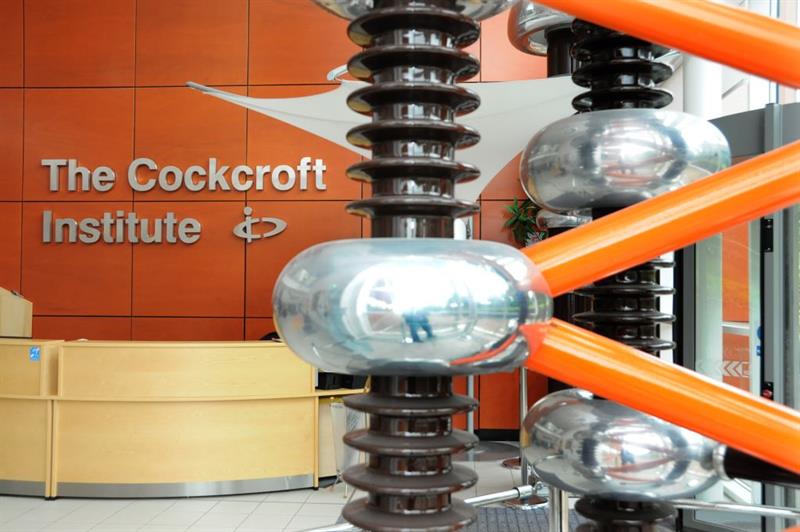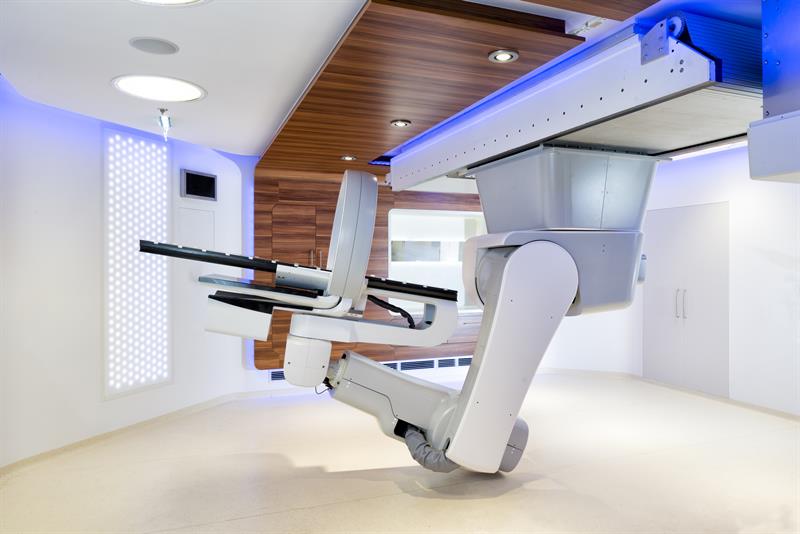Named after the Nobel prize winner Sir John Cockcroft, who, together with Ernest Walton, won the Nobel Prize for splitting the atom for the first time in 1932, the Cockcroft Institute was set up to carry out research into, and the design and development of, particle accelerators.
The Institute is an international centre of excellence for accelerator science and technology and is located in a purpose-built building on the Sci-Tech Campus adjacent to the Daresbury Laboratory and the Daresbury Innovation Centre in Cheshire, in the North West of England. It is a joint venture between the Universities of Lancaster, Liverpool and Manchester, and the Science and Technology Facilities Council (STFC). Recently, it was joined by the University of Strathclyde.
When, or more likely if, people talk about accelerators they tend to think about the massive accelerators, CERN for example, that are being used to reveal the nature of matter and to help us better understand what actually happened at the point when the universe was created.
But accelerators are not only being used for this type of work, in fact the technology is being used to develop new materials and technologies - security scanners and medicines, for example - that could radically change the way in which we live.
“The work we carry out here at the Institute, is cutting-edge,” explains Professor Carsten P. Welsch, Head of the Liverpool Physics Department and Head of Communications at The Cockcroft Institute.
“We are working to push the limits of our ability to control and understand processes that are happening not only at the smallest scale, but at the speed of light.
“While particle accelerators may be best known as being ‘atom smashers’, the experiments from which we are beginning to better understand the basic properties and fundamental forces that shape our universe, their use is certainly widespread and growing.”
Put simply, accelerator science is about accelerating elementary particles, such as electrons and protons, and then colliding those particles at the speed of light. While charged subatomic particles tend to be used, it is also possible to use whole atoms of elements such as gold or uranium, which are much heavier.
“Using a circular accelerator, once we have reached the desired energy level, we can collide particles, creating new particles as well as confirming theoretical particles. For example, the Higgs boson which was proposed in 1964 by the physicist Peter Higgs and confirmed by the ATLAS and CMS collaborations based on collisions carried out in CERN,” explains Prof. Welsch.
“We are setting free particles that have not been seen since the universe was created. We are testing theories and identifying new particles.”
A ten year anniversary
“When the Institute was set up, our vision was to improve and design better particle accelerators,” says Prof. Welsch. He continues, “The Institute was established ten years ago and today we have around 250 staff on site, both professional and students. We also work closely with industrial collaborators both here in the UK and overseas.”
According to the Professor, the Institute and the study of particle accelerators have come a long way in that time.
“When we were set up, accelerator science, as it is understood today, was not an independent science. There were no structured PhD programmes and the engineers and scientists working on the space worked disparately.”
Today, particle accelerators benefit millions of people.
As Prof. Welsch points out,”They help to produce semiconductor chips and tens of millions of patients receive accelerator-based medical diagnoses and therapy each year.”
The most widely known and used products of medical accelerators are X-rays, which are used for imaging and cancer treatment, and radioactive isotopes, which are used for diagnosis.
“In fact, the recent development of proton beam therapies has meant that we are able to offer a far more targeted treatment for particular cancer types,” according to Prof. Welsch.
There are more than thirty thousand particle accelerators operating around the world, although the most well-known are the giant ‘atom-smashers’ at international particle physics laboratories.
Accelerators are now key pillars of modern research across a host of scientific disciplines and countries.
Accelerator applications extend beyond medical applications, described previously and include: material analysis and detection of fraud, investigation of biomolecules, pharmaceutical process control, food preservation, and homeland security.
“We are working on security and medical applications that will start to appear in a matter of a few years,” explains Prof. Welsch.
When the decision was made to set up the Institute it was decided that it should comprise of three elements.
“We settled on a three-fold mix,” continues Prof. Welsch. “We wanted academic institutions out of which ‘crazy’ new ideas could emerge, and academics capable of providing longer-term vision of what could be possible and what accelerators and the science around them could deliver in the future.

“But, while we wanted these institutions to be able to deliver breakthroughs in new technologies, we also wanted industrial collaborators. We needed them to bring those academics back to earth and to encourage greater focus in terms of developing and delivering designs, as well as in the testing, building and assembling of hardware.
As a result, the Cockcroft Institute is very much a collaboration between academia, national laboratories, industry, and the local economy.
“We’ve brought together the best accelerator scientists, engineers, educators and industrialists who, working together, can conceive, design, construct and use the very latest instruments of discovery at all scales,” explains the Professor.
| "We are working to push the limits of our ability to control and understand processes that are happening at the smallest scale." Prof. Carsten Welsch |
One of the key aims of the Institute is to educate the next generation of accelerator experts, and while this is being done through the training of research Fellows, considerable efforts are made to also inspire school students and the wider public.
The Institution is also responsible for a spin-out – D-Beam – which has become the newest member of the STFC CERN Business Incubation Centre.
Prof. Welsch is one of the founders of the company which, last year, unveiled its first commercial device, a sensor that can detect the smallest amounts of beam losses. The loss of particles in a beam accelerator can introduce unwanted ‘noise’ into experiments and can, in extreme situations, actually damage the equipment.
Robust and reliable sensors are therefore critical to ensure accelerators function correctly.
“It’s a great example of taking cutting edge research and creating commercially available tools,” explains the Professor. “It helps us to improve our understanding and control of particle beams.”
International collaboration
The Cockcroft Institute leads the UK’s participation in a number of flagship international experiments through a visitor programme and participation in joint projects.
The Institute contributes to large scale research facilities, such as the Large Hadron Collider (LHC) at CERN, its High Luminosity upgrade programme and the Future Circular Collider projects via the European Design Study EuroCirCol.
Groups from the Institute are also involved in the ALPHA experiment at CERN, and have been leading the development towards an ultra-low energy storage ring at FLAIR and are also a major contributor to the new ELENA facility at CERN.
CI researchers are helping push the boundaries of high intensity accelerators through contributions to the European Spallation Source (ESS) in Sweden and the UK’s neutron science facility ISIS.
The Institute also works closely with industry to apply its knowledge, skills and facilities to a number of industrial challenges, and looks to ensure that the social and economic impacts from cutting-edge accelerator technologies can be fully realised.
“Future advances in accelerator technology will benefit many aspects of our everyday lives,” explains Prof. Welsch.
Scientists and engineers at the Institute are also heavily involved in the development of the underpinning technologies that support accelerator science.

Those skills are varied and the technologies include: end-to-end accelerators; radio frequency (RF) systems; beam diagnostics; vacuum technology; novel coatings for challenges including corrosion resistance, hardness, wear, catalytic performance, optical, electrical and magnetic properties; surface analysis and magnet technology – superconducting and normally conducting, from design and modelling through to testing and operation.
| Established 10 years ago the Cockcroft Institute was set up to improve and design better particle accelerators |
“We have a range of accelerator test facilities, including VELA (Versatile Electron Linear Accelerator), specifically designed to boost development of advanced accelerator systems,” says Prof. Welsch.
New particle physics experiments
Shrinking the size of accelerators, “to make them more practical,” according to the Professor, is seen as crucial and to that end the Institute is involved in cutting edge R&D programmes looking into “frontier accelerators and novel accelerators”.
“These include latter laser and particle beam-driven plasma wakefield acceleration, as well as dielectric laser, photonic bandgap and meta materials accelerators,” explains Prof. Welsch.
AWAKE, which stands for Advanced Wakefield Experiment, is a proof-of-principle compact accelerator project, which aims to accelerate electrons to very high energies over short distances, not the thousand, or so, metres that currently tends to be the case.
| MedAustron, a centre for ion therapy and research, has several irradiation rooms where cancers are treated by using particle accelerators |

The collaboration, based at CERN, involves several UK-based research groups and is supported by the UK Science and Technology Facilities Council (STFC) and has been able to demonstrate the use of plasma waves or so-called wakefields as new way to build small-size, affordable, high-energy particle accelerators.
Accelerating particles to greater energies over shorter distances could enable more laboratories and hospitals to use accelerator science. It could also prove very important in a wide range of industrial and medical applications, such as more compact light sources for patient diagnostics and cancer treatments.
According to Prof. Welsch, “These breakthrough results show, for the first time, that proton-driven electron beam acceleration offers a promising pathway towards the highest energy beams provided by a very compact accelerator. This has the potential to enable entirely new particle physics experiments.
“Our team in Liverpool is developing simulation tools and advanced diagnostic techniques to support and optimise AWAKE, helping to pave the way for entirely new applications.”
The AWAKE collaboration accelerated electrons in plasma for the first time. Electrons injected into AWAKE at relatively low energies of around 19 MeV (million electronvolts) ‘rode’ the plasma wave and were accelerated by a factor of around 100; to an energy of almost 2 GeV (billion electronvolts) over a length of 10 metres.
Current state-of-the-art particle accelerator technologies, considered for the next generation of electron accelerators, promise gradients in the range of just 30–100 million volts per metre (MV/m). These represent today’s most advanced technology for the overall distance over which acceleration can be sustained.
The next steps of AWAKE aim to achieve gradients of 1,000 MV/m.
Plasma is a special state of matter that can be induced by ionising a gas. In AWAKE, rubidium is heated to convert it into a gas and it is then ionised with a laser beam. A proton beam (called the drive beam) is injected along with the laser pulse and causes the plasma to oscillate in a wavelike pattern.
AWAKE gets its drive-protons with an energy of 400 GeV (billion electronvolts) from CERN’s Super Proton Synchrotron (SPS), which is the last accelerator in the chain that delivers protons to the 27km LHC. A beam of electrons (called the witness beam) is injected at a slight angle into the oscillating plasma and get accelerated by ‘surfing’ plasma waves.
While previous experiments of wakefield acceleration have relied on using electrons or lasers to drive the wake, AWAKE is the first to use protons.
“The use of particle accelerators has changed massively since the creation of the Institute,” concludes Prof. Welsch. “Their impact on everyday life is significant and growing. It’s not just about understanding the fundamental building blocks of physics anymore.”













